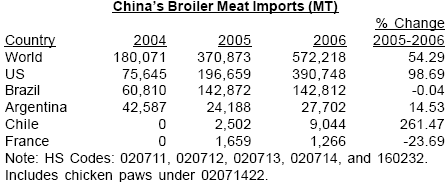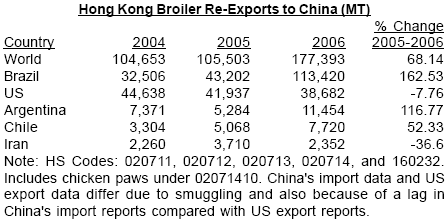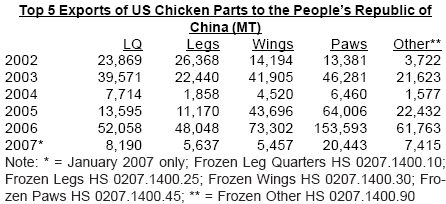



International Egg and Poultry Review
By the USDA's Agricultural Marketing Service - This is a weekly report looking at international developments concerning the poultry industry.China
Post forecasts for China's 2007 broiler production predict an increase of 2% over 2006 to 10.5 million metric tons (MMT). With China's current slow production growth rate and its consumption rates still recovering from avian flu outbreaks in recent years, the US stands to gain as imports are expected to increase. Yet even with China's improved broiler meat and feed conversion ratios, the country's broiler production growth will continue to be constrained by its heavy dependency on domestic corn production, which is also being used for alcohol and ethanol fuel production, as well as imports of fish meal and imports of soybeans and soy meal products. China's depleting supply of natural resources, vanishing croplands, and diminishing water stores are forcing China to heavily import soybeans from the US and Brazil, which are experiencing fluctuating world prices as the feedstuff competes with the production of biofuels. Presently, Brazil is striving to be China's largest supplier of soybeans, but struggles with political red tape, its bottleneck transportation system, and the strength of the Real against the US Dollar. Brazil welcomes Chinese investment, but worries about becoming too dependent on China so it is now working with Americans to diversify its customer base with India as well.
Other obstacles impacting China's ability to increase broiler production stem from outbreaks of highly pathogenic avian influenza (HPAI). On OIE's last report on March 6, 2007 China reported a total of 8 outbreaks of HPAI in three provinces accounting for the loss of 11,320 chickens and other wild bird species. In light of these events, China has strengthened its disease monitoring at live wet markets requiring all sellers to show certification proving the birds came from HPAI-free areas, replaced live poultry slaughtered at wet markets with poultry slaughtered at designated slaughterhouses, initiated a massive compulsory immunization program in early March 2007 for all poultry to be immunized before May, and increased monitoring by experts of breeders, live poultry markets, and border and region area inspections. Beijing recently closed all of its wet markets.
Broiler imports are forecast to rise 25% from 343,000 MT in 2006 to 430,000 MT in 2007. Imports of broiler meat, excluding paws, recovered 76% of levels prior to HPAI outbreaks in 2003 (453,000 MT) and are projected to continue recovering in 2007 to 95% (430,000 MT). In 2006, the US was China's top supplier of chicken meat with Brazil hot on its heels even though only one company was eligible to export in 2006. In the mean time, Brazil faces challenges with the strength of the Real and its domestic demand continuing to recover, yet it is still seeking the approval of more poultry plants. France, China's fourth largest supplier, was suspended in January 2007, due to recent outbreaks of HPAI.
According to the March Livestock, Dairy, and Poultry Outlook report, US broiler meat exports to China and Hong Kong accounted for 12% of fourth quarter 2006 exports and are expected to continue rising in 2007, while turkey meat exports in January 2007 increased from 801,000 MT in 2006 to 4.8 million pounds. Also, as of early March 2007, all US meat plants were required to send e-mail notification to AQSIQ (General Administration of Quality Supervision, Inspection and Quarantine) when USDA FSIS certifies a shipment to China. Soon the US will be required to send the FSIS meat export health certificate via electronic notification like its competitors in Australia and New Zealand are already doing.
Exports of Chinese broiler meat are projected to rise 2% to 330,000 MT in 2007 from the previous year's 3% loss. Most of the broiler meat will be exported to Japan, Hong Kong, and South Korea, while exports of shell eggs are forecast to increase 2% to 1.2 million pieces to mostly Hong Kong and Macau, which account for 90% of China's exports. However China has recently experienced some adverse international media attention concerning food safety concerns with incomplete labeling, and food contaminations with pesticides, chemical fertilizers, harmful antibiotics, and other drugs and pollution hazards. In response, Hong Kong has toughened food inspections, is currently drafting legislation to better regulate all food imports, and has banned some food imports along with Europe and Japan.
Source: USDA FAS/OIE/USDA ERS/news wires

Source: WTA/GTA China Customs Statistics

Source: WTA from Hong Kong Census and Statistics Department

Source: USDA FAS








